PIROP
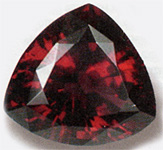 Characteristics of the mineral.
Characteristics of the mineral.
A pyropa is a kind of pomegranate, a frequent companion of a diamond. The purest, brightest and fiery color of a magnesian-aluminum garnet is pyrope. The name of the mineral hints at the dark red color of the stone. All the magic of pomegranates in their color. It is a beautiful bright red color. In translation from the ancient Greek pyropos - similar to fire (Greek pyros - fire). The Mongols call the pyropes of Galyon Chulluu - a fiery stone. In the old days, they believed that it was a piece of a volcano erupting from a frozen fire, capable of glowing in the night. Other legends tell us that pyropes are the frozen drops of the dragon's blood, which gives people extraordinary strength and fearlessness. The soldiers of Tamerlane before the battle drank pomegranate juice from a bowl made of this fiery stone for courage. The best pyrops for centuries were mined in the Czech Republic, the development of local deposits began in the Middle Ages. Another source of jewelery quality pyrope is southern Africa.
The pyrope is a magnesian garnet with the formula, however, minerals of other garnets (almandine, spessartine, uvarovite, etc.) are usually present in this or that quantity. Pure pyrope should be colorless, but due to the presence of impurities in it, it has red, pink, reddish-violet, orange-red, purple, raspberry, cherry, sometimes there are pyropes with alexandrite effect. The main impurity that determines the color of the pyrope is the chromium ions. The admixture of iron in garnets with a low chromium content determines the reddish-orange coloration. In pyrope from Yakut kimberlite pipes, which are characterized by a high content of uvarovite mineral, an alexandrite effect is observed (green color in daylight and red under artificial lighting).
The pyropas are usually found in the form of rounded grains, less often in the form of regular, well-formed crystals ranging in size from 10 mm. Larger crystals are extremely rare. Pirops of the Central Bohemian Mountains for a long time had no competitors in the world market. The output of jewelry raw materials in placers is up to 40%. South African pyropes differ in beautiful color and considerable size. Pyropes are also known in Tanzania. Beautiful pyropes are also found in the USA, Brazil, Argentina, Australia, Norway. In some kimberlite (diamond) tubes of Yakutia, jewelry pirogues have also been found. It is of interest to carry them out in the extraction of diamonds. Diagnosis of pyrope usually does not cause great difficulties. It is most difficult to distinguish it from red spinel. The pie can be confused with ruby, tourmaline, synthetic materials.
Pyropes are the only garnets that rarely occur in the form of polyhedra (only in parent rocks). They often form phenocrysts. Therefore, they do not have faceting and in their natural form they are matte, small, black-red grains in placers. Pyropes occur in the lavas of the basic composition and in the explosion tubes, as diamonds. They are found in kimberlites, in volcanic breccias - lava-cemented clastic volcanic rocks. Since the discovery in African diamond tubes that the pyrope is a faithful companion of a diamond, scientists have searched in volcanic olivine-bearing rocks. And among the Yakut pyropes, there were also found splices with diamonds, even sprouts of garnets in diamonds. Pyropes, like raisins in the test, are occasionally caught in meteorites, and hence can be met in other planets.
In the homeland of the pyropa in northern Bohemia in the town of Trebnitz (Czech Republic) a personal museum was built for him. It holds the world's largest pyropa the size of a pigeon egg. This is a unique car of 468.5 carats. The most destructive competitor at one time for the best Czech pyrope was the Czech pomegranate glass.
Magic properties of stones.
According to the yogic concepts, the pyrope is poured in a saturated blood-red color with a normal energy balance and dims when it breaks. Indian yogis believe that wearing pyropes is useful to people who are energetic and powerful, in constant tension. The pie helps to keep them their energy potential. This stone is considered a symbol of heart feelings, it brings good luck in love and friendship, it is also called a stone of honesty. A piroper is a talisman of lovers, it is presented as a sign of friendship, memory and love. It must be remembered that pyrope can not be worn constantly. This stone is not recommended for people to be nervous and passionate, as pyrope can only strengthen these aspects of their nature.
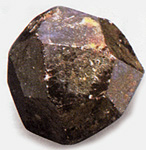
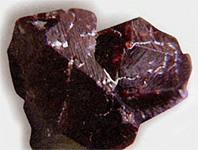


RHODILITE
 Characteristics of the mineral.
Characteristics of the mineral.
In translation from Greek, the rhodolite is a pink stone. This mineral is a dense pink variety of pyrope. Pyros in Ancient Greek fire. It is no accident that pyropes belong to a large group of pomegranates, before they were otherwise called Cuban rubies. Faceless rodoliths and pyropes layman can easily be confused, for example, with a noble spinel. Externally, these stones are similar. Sometimes there are pyropes, which are green, lilac, blue in daylight, while in artificial light they are lilac, crimson, violet. Large rhodolites are extremely rare, they are very valuable. The largest rhodolite had a mass of 43.3 carats. Usually the color of jewelry stones is determined by eye, based on their comparison with the reference spectral shades. In color, the rhodolites turn out to be similar to those of a pomegranate or almandine.
Rhodolite in composition is the middle member of the isomorphous pyrope-almandine series. Its beautiful pink, reddish-pink color is associated with the presence of Fe2 + ions (ferrous iron) in it. It occurs in the form of well-formed crystals up to 2 cm in size. Separate findings of larger crystals are known. Rhodolite deposits are associated with metamorphic hypersthene gneisses, in which it is found in the form of phenocrysts (characteristic rhodolites in the rock in the photo on the right). Such are the deposits in the USA (North Carolina), which in the XIX century. Basically have already been worked out. Jeweled rhodolite was mined in passing with abrasive grenades. There is a rhodolite in Tanzania, Zimbabwe, Sri Lanka, Madagascar. However, the existing deposits do not fully satisfy the demand for this beautiful jewel stone. In connection with which there is an increase in prices for rhodolite (costs more than jewelry pyrope and almandine).
Magic properties of stones.
According to some beliefs, faceted rhodolites give the owner vitality and excite passion in him. Rhodolites advise people to wear power, constantly in active state.
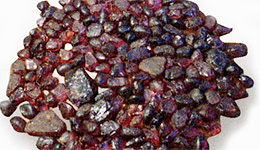
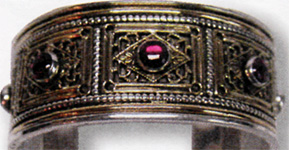
Poisonous and radioactive dangerous stones and minerals
** - poisonous stones and minerals (mandatory check in the chemical laboratory + explicit indication of toxicity).
** - radioactive stones and minerals (mandatory check on the standard dosimeter + ban on open sales in the case of radioactivity over 24 milli / g / h + additional measures of population protection).
All rare stones are subject to mandatory inspection at the standard dosimeter for the permissible level of radiation and in the chemical laboratory for the absence of poisonous and evaporating components that are dangerous to humans and the environment.


Comments
Commenting on, remember that the content and tone of your message can hurt the feelings of real people, show respect and tolerance to your interlocutors even if you do not share their opinion, your behavior in the conditions of freedom of expression and anonymity provided by the Internet, changes Not only virtual, but also the real world. All comments are hidden from the index, spam is controlled.